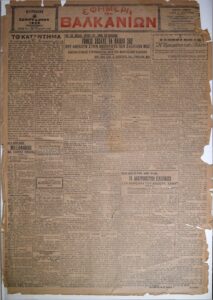Islahane: neighbourhood, home, school
City
Migration Period
Category
Full Description
The Hamidiye vocational training school, also known as Islahane, was located on the eastern end of Agiou Dimitriou Street, between Apostolou Pavlou Street and Elenis Zografou Street. The complex comprised three buildings, two of which were inside the walls and one outside.
Islahane was preceded by the Numan Pasha building compound, which included a mosque, a seminary, an orphanage, a mausoleum and a hammam (Turkish bath). Islahane started operating around 1875 as part of the Ottoman state’s modernisation reforms and its mission was to provide care and vocational training to orphaned children. Islahane gradually expanded and at the turn of the century, in 1902, one more building was erected outside the walls, housing a machine shop as well as carpentry and smithery workshops. This is the only building that still survives today. In 1912, ownership of the complex was transferred to the local Mufti.
From 1920 onwards, the machine shop building was rented out for industrial use. From the end of the 1920s until 1989, it was rented by the Axylithiotis family, whose name became closely associated with the building. In 2003, the building was ceded by the Public Properties Company to the Modern Monuments Authority which formulated a proposal for its reconstruction and reuse. The Islahane Cultural Centre, former Hamidiye vocational training centre, has been operating since 2017, run by the Service of Modern Monuments and Technical Works of Central Macedonia. It houses a permanent collection on the history of the complex and the factory, and hosts temporary exhibits, theatre shows, concerts and a wide array of cultural events which foreground the history of the complex and the entire neighbourhood. The operation of the cultural complex revived the name ‘Islahane’, which had been used for the wider area until the mid-20th century.
The dormitory of Islahane initially housed Muslim refugees from the areas surrounding Thessaloniki, but after 1922, it accommodated refugee families from Asia Minor, Pontus and Thrace. Many of them stayed in the building until the mid-1960s, when they were finally granted houses in other parts of the city. Later, the building was abandoned and fell into disuse, leading to its demolition in 1980 to make way for Olympiados Street.
In their accounts, Georgia Sarigiannidou and Tasos Kefalidis describe the life conditions and the anthropogeography of the Islahane dormitory during the 1950s and ‘60s, and talk about the self-organisation and solidarity among its tenants. Toula Markopoulou talks about the self-organised nursery school attended by some of the neighbourhood children and Konstantinos Loukidis tells the story of his grandfather’s coffee shop on Apostolou Pavlou Street. All four narratives were collected, among others[1], by Areti Kondylidou, an archaeologist and social anthropologist working for the Service of Modern Monuments and Technical Works of Central Macedonia, after an open call for materials and intangible historical evidence about the neighbourhood of Islahane was extended by the Culture Complex in 2019 on the occasion of International Museum Day. The narratives present the micro-history of the neighbourhood and its people, most of whom were of refugee origins, while additional narratives were collected focusing on the everyday life of the workers at the Axylithiotis machine shop. The latter are part of the permanent collection of the Islahane Culture Complex.
The school of Islahane was inside the walls and was located approximately where Thessaloniki’s 3rd Middle School and 3rd High School[2] can be found today. After 1925, the building housed the city’s 3rd Middle School for Boys, gathering the student population of Ano Poli. Nikos Kastrinos, in his article in Efimerida ton Valkanion on 6/1/1929, wrote extensively about the 3rd Middle School and its horrible building facilities: ‘It’s truly a refugee school, because all the attendees are refugees with the need for education burning within them but no access to the necessary means. Both the exterior and the interior of the building are worse than disgraceful. Even if I were to describe its horrific condition, I doubt I would be believed, as I cannot imagine a building more wretched and less appropriate. I can’t help but wonder how the people responsible found it and decided to use it as a school. I am certain that their servants’ stables are better suited for the purpose’.
[1] All the narratives are available here: http://www.ppxi.gr/index.php/2020-10-29-10-48-24
[2] Thessaloniki’s 3rd High School has been named after Giorgos Ioannou, an alumnus who went on to become a writer and often mentions Islahane in his works.
Bibliography
The Axylithioti Company archive, Islahane Culture Complex, Service of Modern Monuments and Technical Works of Central Macedonia.
The Islahane Culture Complex website http://www.ppxi.gr/index.php/homepage
Sofia Christoforidou, Areti Kondylidou, Evangelia Mesochoriti, Anna Syrgianni, Anastasia Valavanidou, ‘The Islahane of Thessaloniki: a modern monument, a token of technical education as an instrument of resettlement of orphan children’, Thessaloniki, Scientific Yearbook of Centre of History of Thessaloniki, Municipality of Thessaloniki, issue 8 (2013), pp. 237-266.

